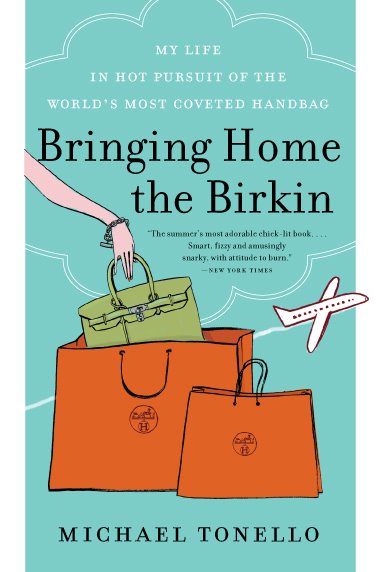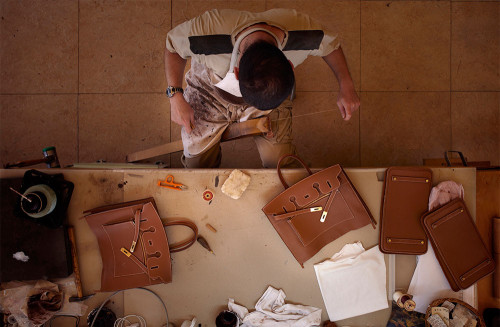The Humanity of Hermès
How does a company that proudly eschews the usual means of generating desirability remain the most desirable luxury brand in the world?

An artisan prepares leather pieces to be made into a handbag | Source: Courtesy Hermès
Dumas, who is half-Greek and knew the staff ’s maker, vividly explains how it was created from a single branch, patiently trimmed until it grew sufficiently tall and straight, then steam-bent at one end to get the curvature of the handle just right.
This beautifully encapsulates Dumas’ ideas on design, craftsmanship and life. The staff’s rudimentary, hand-made elegance is elevated by its thought-out functionality, a combination that takes on an even deeper sense of humanness from its precise connection to a place and a person that Dumas lovingly relates.
And while he can sometimes sound more like a scholar of Eastern philosophy than a creative director, the 47-year-old’s thoughtful ruminations about what makes his family business not only tick but thrive are the opposite of grandiloquent.
The cane once belonged to Dumas’ father, Jean-Louis Dumas, who, over the course of his 30-year tenure, turned Hermès into the global enterprise it is today.
In 2013, the group’s consolidated revenue totalled €3.75 billion (about $5.2 billion), a 13 percent increase over 2012, at constant exchange rates, with an operating margin of 32.4 percent, the highest ever recorded in the company’s history. And while major luxury rivals like Louis Vuitton and Gucci have experienced slowing growth in the all-important Chinese market, Hermès’ sales in China continued to grow by double-digit percentage points.
No wonder LVMH has shown an interest in Hermès, quietly building a stake of about 17 percent in the company between 2002 and 2010, leading to a fractious and drawn out legal dispute between the conglomerate and Hermès. LVMH now retains a 23 percent stake in Hermès, but was fined €8 million (about $11 million) last year for violating public disclosure requirements. A separate criminal investigation is under way.
But over at the Faubourg, as everyone at Hermès refers to the company’s headquarters, people seem to go about their work quietly, and happily. The mood is calm and zen-like — but also focused and business-like.
“We belong neither to the world of luxury nor to the world of fashion,” Dumas tells BoF in his light-filled office in the heart of the Faubourg. “This is a family house that goes back six generations. We did not invent our craft, we are the recipient of an age-old tradition, mixed with something which is perhaps proper to my family — a desire for excellence — and maybe something a little bit obsessive and mad about detail.”
Talking to Dumas and other leading figures at Hermès, one realises that everything you think you know about this venerable brand — from the company’s fabled history to its near-fanatical dedication to craftsmanship — is, at once, more layered and less mysterious when seen from the inside.
Take creativity, for instance, the lifeblood of any company in the business of designing and selling beautiful things.
“What Hermès is always searching for is this ideal of beauty, of perfect shape. The right thing, the good thing, the beautiful thing,” says Pierre Hardy, creative director of the brand’s footwear and fine jewellery divisions. “It’s something that people are afraid to talk about. Nobody talks about the beauty of something anymore, but when people see it they recognise it.”
Dumas, likewise, channels his own worldview to illuminate the brand’s unique attitude towards beauty. “I believe anyone can reach eternity in an instant. When I look at our collections, I am always looking for that miraculous moment when I am surprised and feel such a strong emotion that that moment is like pure gold and stops time as we know it,” he says. “That to me is the experience of beauty or grace, a feeling of absolute timelessness, but you can also experience it through shape or colour.”
It’s sincere convictions such as these that explain the zealous quest for perfection espoused by the craftsmen, designers and illustrators who work for Hermès. “Every Hermès object has to be perfectly done and in the best material and in the best way, that’s a matter-of-fact for us, a basic standard. If it’s saddle, it has to be the perfect saddle, and the same goes for every other category,” explains Hardy.
But high-minded ideals aside, even Dumas acknowledges that the goal of so much creative zeal is the necessity, at the end of the day, to produce things that people want to buy. “The delicacy of a fabric, the touch of soft leather, the scent of a fragrance. I want people to come into a Hermès store and smile and think ‘I want that, I need to have that, because I like it.’”
Right away, however, almost as if he were constitutionally obliged to imbue what might have been a pragmatic statement with a touch of philosophy, he adds: “I want our customers to indulge in a moment of pure lightness, because it is in those moments of dream where you have insights into life, and into the future.”
Indeed, the “pure lightness” and reverie that Dumas likes to evoke are at the very heart of the Hermès universe. It was what first struck Christophe Lemaire, Hermès’ artistic director of women’s ready-to-wear, long before the brand became his employer (he succeeded Jean-Paul Gaultier in 2011).
“I remember well when I was much younger, I used to go for lunch near the Madeleine [church] and I was fascinated by Hermès’ windows, by their excellence and quality, but also by their whimsy and generosity. There was always something quite charming, something not completely controlled; the poetry of the windows really touched me, the colours and richness of textures. I always thought, ‘what a beautiful house,’” recalls Lemaire.
According to Dumas, the brand’s window displays are a portal into the culture of Hermès. “I would say that the way we communicate at Hermès today can find its root in the art we developed of making our windows,” he says. “The only purpose of Hermès’ windows [has been] to please people.”
This ethos is reflected in all of the ways Hermès relates with the public, from its events — charmingly old-fashioned affairs devoid of strained efforts to appear sexy or cool — to the near-absence of celebrities in the brand’s advertising.
Indeed, Dumas doesn’t hide his distaste for the prevalent PR and marketing tactics of our times. “One thing I deeply dislike is a form of cynicism and trying to manipulate people’s minds. Everything we do [at Hermès], we do it because we believe in it — it has to be meaningful and relate to what we are trying to express.”
Lemaire singles out the relative spontaneity with which things are done at Hermès as one of its main assets, suggesting that the playfulness customers often perceive in the brand’s offering is in direct measure to the company’s inner workings, and only, therefore, so effective.
“Everybody works very hard at Hermès, but in a very lively way. I had never experienced that in my previous [work] experiences,” says the designer. “Sometimes, [it’s] a little bit naive. The quality, the product, and the creativity always come first, before any marketing — that is very much rooted in the Hermès working culture. I think that’s what makes the difference. When you try hard to please and seduce, and you anticipate what people expect from you, it doesn’t work. It’s better to know who we are, be ourselves and believe in our own values, and they can be universal, if they’re true.”
Lemaire attributes the enormous goodwill the brand enjoys among its customers to the company’s honest and lighthearted stance. “At times it seems like the fashion and luxury world has become a little bit like a war [zone]. And Hermès doesn’t want to play that game. At Hermès, we are very confident in what we stand for and in the excellence of our work. And basically the client understands that, which is the main point at the end of the day.”
But as the world has changed, so has Hermès. Today’s company is a far cry from its origins as a small enterprise of workshops piled on top of each other making dreams come true for a mostly French clientele. Hermès is now a large, global, publicly traded company. So, how does it keep the creativity that feeds its success flowing? By reinventing itself, again and again.
Every year, Dumas gives his creative teams a theme, a leitmotif, to inspire and challenge creation across divisions, and to help reconfigure the house’s codes in a fresh way. For 2014, Hermès’ creative theme happens to be ‘Metamorphosis.’ As Dumas put it, “[It’s about] the ability to reinvent ourselves season after season. It is through constant change that we actually remain the same in spirit and are able to maintain our culture.”
While much is made about the Hermès’ unchanging values —its dedication to creativity, craftsmanship, and quality — over its 177-year history, an unusual commitment to reinvention and change has played an equally important role in maintaining the brand’s currency.
Specifically, while craftsmanship and excellence have remained the house’s constant, fiercely upheld values, it’s the way their application has evolved and been repurposed that has propelled Hermès to the pinnacle of the global luxury market. Without the farsighted decision, generations ago, to transfer its core expertise into new areas in order to ensure its future, Hermès would have never grown from a saddlery into a thriving multinational luxury goods enterprise.
It was Pierre-Alexis’ great-grandfather Emile who, in the 1920s, in order to stay in business, decided to apply harness- and saddle- making techniques to other fields — namely, the creation of luggage and bags. Hence the Kelly bag’s famous saddle-stitch. The same adaptability and gift for reinvention characterises Hermès today.
While everyone loves to talk about the importance of craftsmanship at Hermès, Dumas himself is quick to emphasise that artisanal excellence in and of itself means little if it isn’t applied in a timely and business-savvy way. “Craft can only survive if it finds a natural application and if it finds a market. What a craft produces has to be relevant to the world we live in today,” he says. “If craft does not reinvent itself, it dies. If we were still making harnesses, Hermès would not exist anymore.”
“That is why we constantly re-design [things] and try find new applications and new ideas all the time — because that’s what keeps craft alive. It’s production. It’s the ability to make objects that will sell.”
But it’s impossible to assess the culture of Hermès without considering what is perhaps its most important element: the people who make up the organisation. In a day and age where people change jobs with increasing frequency, at Hermès it’s not unusual to meet employees who have worked with the company for decades. Véronique Nichanian, for instance, artistic director for Hermès’ menswear collections, joined the company in 1988. And the same woman — Leila Menchari, an institution unto herself — has been doing the Faubourg flagship’s famous window displays for more than 35 years.
“Everyone always talks about the beauty of the craftsmanship, about the Kelly bags, the excellence of quality, and so on, and obviously all this is amazing. But what I think is most distinctive of Hermès is its work culture. The importance of human relationships for Hermès is something that is difficult to explain unless you have experienced it,” says Lemaire.
Undoubtedly, being a family-run business has shaped the culture of Hermès more than anything else. But crucially, the idea of family extends beyond the immediate Hermès clan. As Lemaire pointed out, “It’s not a pyramidal organisation like other luxury brands — it’s more like a family, it’s all very spontaneous, and sometimes can even appear a bit messy.”
And yet, this is “an old, young house,” as Dumas puts it. The most striking thing about a visit to the company’s leather factory in the Saint Antoine neighbourhood of East Paris is the number of young craftspeople working and training on the brand’s coveted bags. Far from the grouchy guard of old white men and women one might expect, here one encounters a population that is a surprisingly harmonious cross-section of French society today.
From a pierced and tattooed girl with a shaved head, to black, white, Asian, Muslim, old, young, gay and straight artisans, at Saint Antoine a seemingly happy mix of people with diverse backgrounds go about their craft with the same serene concentration one encounters among the employees at the Faubourg.
It was Jean-Louis Dumas who reinvented the notion of craftsmanship to make it the symbolic and practical backbone of a contemporary luxury goods company with an international distribution network. “My father had a double vision. [Along with international expansion, he] introduced a notion of contemporary craftsmanship. He asked himself, ‘What is the space of the craftsman in a fast-changing modern world?’ and saw it as his responsibility to create a truly modern manufactory, where a craftsman would be treated with respect in order to continue to be able to do the best work with his hands.”
This guiding ethos, to provide a workplace where artisans are given the space and respect to work under conditions that are as close to ideal as possible, thus enabling them to identify with their profession and produce at an according level of quality and efficiency, is put into practice at the 31 manufacturing facilities Hermès operates across France. (There are 37 “manufactures” worldwide.)
No more than 200 people — a cap intended to maintain a human scale and foster a sense of community — work at any of these centres, often at ergonomically designed workstations in daylight-flooded, wood-and-concrete facilities that wouldn’t look out of place in a magazine for progressive architecture.
But can good work conditions alone account for why people stay at Hermès for so long? Maybe not. Perhaps, in today’s world, it takes more. Indeed, Pierre-Alexis Dumas inherited his father’s sense of responsibility, but he has expanded that vision with his own contemporary, idealistic imprimatur.
For the socially-conscious man currently at the creative helm of Hermès, the entire design process must be accountable, while offering employees an opportunity to make a difference. “If there’s one thing I have learnt, it’s that you have to think hard about what you do; at Hermès, we think about the shapes and objects we create — it’s a responsibility. You have to think about the consequences, how what you make will affect people’s lives.”
Consequently, Dumas thinks the company’s level of employee satisfaction has to do with the larger sense of purpose that Hermès provides. “I think people enjoy working for Hermès because they feel that what they do is meaningful. If you have the feeling that what you do somehow generates something positive, today, that’s what makes you want to stick to the company you work for. And I try to reinforce that feeling of working for a company that stands up for certain humanist values that are relevant.”
“I think Hermès objects are desirable because they reconnect people to their humanity,” says Dumas. “[Our customer] feels the presence of the person who crafted the object, while at the same time the object brings him back to his own sensitivity, because it gives him pleasure through his senses.”
“I see Hermès as an oasis. I see us as the recipients of a very important culture which is related to the human hand and a sense of respect for each other,” reflects the great-great-great grandson of Thierry Hermès, who founded the company in 1837.
“A company that makes only money is quite poor, that’s for sure.”
http://www.businessoffashion.com/2014/04/humanity-hermes.html


No comments:
Post a Comment